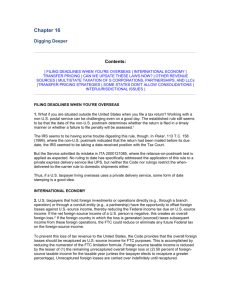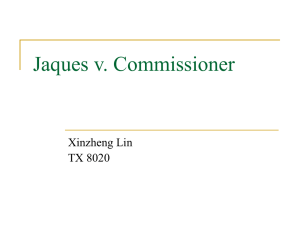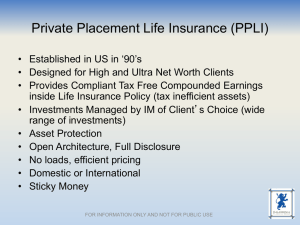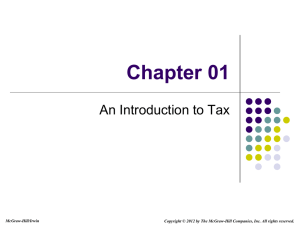Chapter 12 - Cengage Learning
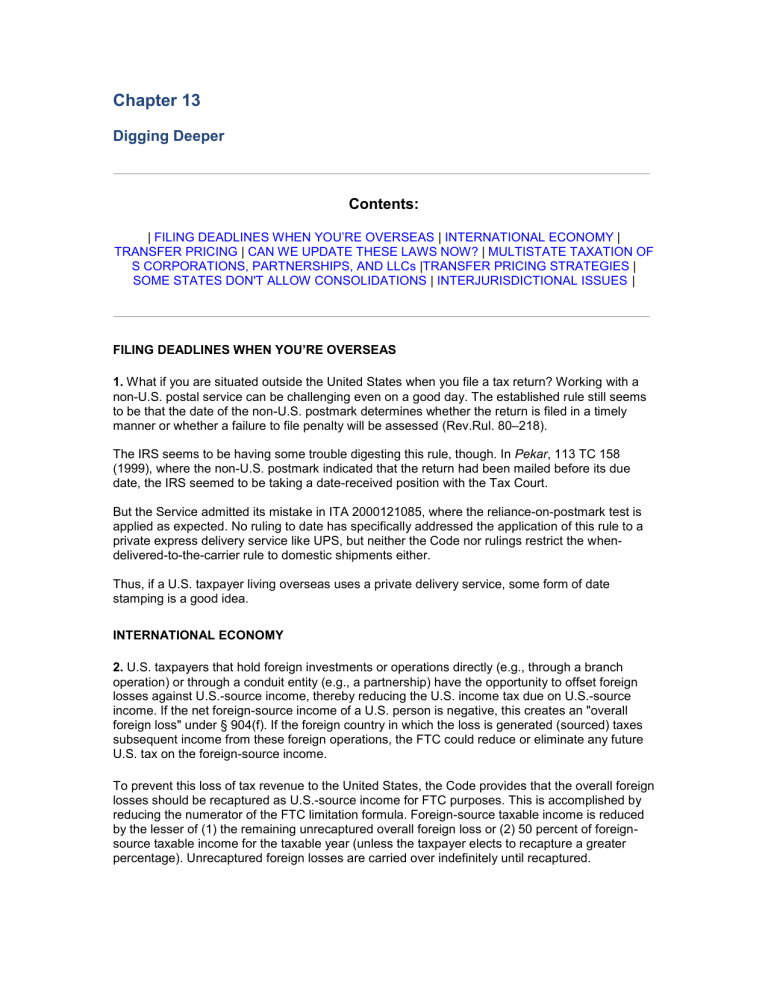
Chapter 13
Digging Deeper
Contents:
| FILING DEADLINES WHEN YOU’RE OVERSEAS | INTERNATIONAL ECONOMY |
TRANSFER PRICING | CAN WE UPDATE THESE LAWS NOW?
| MULTISTATE TAXATION OF
S CORPORATIONS, PARTNERSHIPS, AND LLCs | TRANSFER PRICING STRATEGIES |
SOME STATES DON'T ALLOW CONSOLIDATIONS | INTERJURISDICTIONAL ISSUES |
FILING DEADLINES WHEN YOU’RE OVERSEAS
1. What if you are situated outside the United States when you file a tax return? Working with a non-U.S. postal service can be challenging even on a good day. The established rule still seems to be that the date of the non-U.S. postmark determines whether the return is filed in a timely manner or whether a failure to file penalty will be assessed (Rev.Rul. 80 –218).
The IRS seems to be having some trouble digesting this rule, though. In Pekar , 113 TC 158
(1999), where the non-U.S. postmark indicated that the return had been mailed before its due date, the IRS seemed to be taking a date-received position with the Tax Court.
But the Service admitted its mistake in ITA 2000121085, where the reliance-on-postmark test is applied as expected. No ruling to date has specifically addressed the application of this rule to a private express delivery service like UPS, but neither the Code nor rulings restrict the whendelivered-to-the-carrier rule to domestic shipments either.
Thus, if a U.S. taxpayer living overseas uses a private delivery service, some form of date stamping is a good idea.
INTERNATIONAL ECONOMY
2.
U.S. taxpayers that hold foreign investments or operations directly (e.g., through a branch operation) or through a conduit entity (e.g., a partnership) have the opportunity to offset foreign losses against U.S.-source income, thereby reducing the U.S. income tax due on U.S.-source income. If the net foreign-source income of a U.S. person is negative, this creates an "overall foreign loss" under § 904(f). If the foreign country in which the loss is generated (sourced) taxes subsequent income from these foreign operations, the FTC could reduce or eliminate any future
U.S. tax on the foreign-source income.
To prevent this loss of tax revenue to the United States, the Code provides that the overall foreign losses should be recaptured as U.S.-source income for FTC purposes. This is accomplished by reducing the numerator of the FTC limitation formula. Foreign-source taxable income is reduced by the lesser of (1) the remaining unrecaptured overall foreign loss or (2) 50 percent of foreignsource taxable income for the taxable year (unless the taxpayer elects to recapture a greater percentage). Unrecaptured foreign losses are carried over indefinitely until recaptured.
Example: Shannon, Inc., a domestic corporation, operates a branch in Japan. The earnings record of the branch is as follows.
Year
2011
2012
2013
2014
Taxable Income (Loss) Foreign Taxes Paid
($15,000) $ -0-
(20,000)
(20,000)
40,000
-0-
-0-
20,000
For 2011 –2014, Shannon has U.S.-source taxable income of $300,000 each year. Shannon's
2014 U.S. tax liability (on taxable income of $340,000) before the FTC is $115,600. Its overall foreign loss is $55,000 for 2011 –2013. The FTC limitation for 2014 is $6,800 {$115,600 ×
[$40,000
(50% × $40,000)]/$340,000}. Without the overall foreign loss recapture rule,
Shannon's FTC limit would have been $13,600.
TRANSFER PRICING
3.
Taxpayers, either U.S. or foreign, may be tempted to manipulate the source of income and the allocation of deductions arbitrarily to minimize U.S. taxation. This manipulation is more easily accomplished between or among related persons. The IRS uses § 482 to counter such actions.
The provision gives the IRS the power to reallocate gross income, deductions, credits, or allowances between or among organizations, trades, or businesses owned or controlled directly or indirectly by the same interests. This can be done whenever the IRS determines that reallocation is necessary to prevent the evasion of taxes or to reflect income more clearly.
Section 482 is a "one-edged sword" generally available only to the IRS. The taxpayer typically cannot invoke it to reallocate income and expenses.
The reach of § 482 is quite broad. The IRS takes the position that a corporation and its sole shareholder who works full-time for the corporation can be treated as two separate trades or businesses for purposes of § 482. Two unrelated shareholders who each owned 50 percent of a corporation were held to be acting in concert for their common good and, thus, together controlled the corporation.
In applying § 482, an arm's length price must be determined to assign the correct profits to related entities. Several alternative methods can be used in determining an arm's length price on the sale of tangible or intangible property. The major problem with most pricing methods is that uncontrolled comparable transactions are needed as a benchmark.
An accuracy-related penalty of 20 percent is provided by § 6662(e)(1)(B) for net § 482 transfer price adjustments (changes in profit allocations by the IRS) for a taxable year that exceed the lesser of $5 million or 10 percent of the taxpayer's gross receipts. In addition, there is a 40 percent penalty for "substantial valuation misstatements." As an aid to reducing pricing disputes, the IRS initiated the Advance Pricing Agreement (APA) program whereby the taxpayer can propose a transfer pricing method for certain international transactions. The taxpayer provides relevant data, which are then evaluated by the IRS. If accepted, the APA provides a safe-harbor transfer pricing method for the taxpayer.
CAN WE UPDATE THESE LAWS NOW?
4.
Both the permanent establishment (PE) and the nexus rules are in desperate need of updating to reflect a service-based and cyberspace-oriented environment. The PE rules seem to reflect the chiefly European dependence on property tax collections, and so they require a much greater
level of financial investment than now would be required of an Internet-savvy seller. PE cases relate for the most part to the interpretation of treaty language that was crafted decades ago — even treaties enacted today tend to re-use the time-tested language of the long-standing treaties between the United States and its European trading partners.
And the nexus rules, as interpreted by the U.S. Supreme Court in the mid-1990s, largely ignore the use of telephones, fax machines, computers, and handheld devices in conducting business.
At a time when seemingly every third television commercial hawks one wireless device or another, why must our tax laws be so dated?
MULTISTATE TAXATION OF S CORPORATIONS, PARTNERSHIPS, AND LLCs
5.
Multistate Taxation of S Corporations . The majority of the 46 states that impose a corporate income tax have special provisions, similar to the Federal law, that govern the taxation of S corporations. As of 2011, only a few states —including Texas and Tennessee—and the District of
Columbia do not provide special (no corporate-level tax) treatment for Federal S corporations. In addition, Massachusetts imposes a corporate-level tax on S corporations that have gross receipts in excess of $6 million. Some states, including Illinois, Texas, and California, apply a corporatelevel tax, at special rates, on an S corporation.
In the non-S election states, a Federal S corporation generally is subject to tax in the same manner as a regular C corporation. Accordingly, if a multistate S corporation operates in any of these states, it is subject to state income tax and does not realize one of the primary benefits of S status —the avoidance of double taxation. Other potential tax-related benefits of the S election, including the pass-through of net operating losses and the reduction in the rate of tax imposed on individual and corporate taxpayers, may be curtailed.
Eligibility.
All of the states that recognize S status permit a corporation to be treated as an S corporation for state purposes only if the corporation has a valid Federal S election in place.
Generally, the filing of a Federal S election is sufficient to render the corporation an S corporation for state tax purposes. In most states, an entity that is an S corporation for Federal tax purposes automatically is treated as an S corporation for state tax purposes. Wisconsin allows the entity to elect out of its S status for state purposes.
Corporate-Level Tax . Although S corporations generally are not taxable entities, Federal income tax liability may arise if the corporation has excess passive investment income or recognized built-in gains (see Chapter 12). Several states have adopted similar provisions, and, therefore, an
S corporation is exempt from the related state income tax only to the extent that it is exempt from corresponding Federal income taxes. In the majority of these states, the imposition of Federal income taxes generates a corporate-level tax for state purposes to the extent that corporate income is allocated or apportioned to the state.
Taxation of Partnerships and LLCs.
Most states apply income tax provisions to partnerships, limited liability companies (LLCs), and limited liability partnerships (LLPs) in a manner that parallels Federal treatment. The entity is a tax-reporting, not a taxpaying, entity. Income, loss, and credit items are allocated and apportioned among the partners according to the terms of the partnership agreement and state income tax law. See Chapter 11.
Some states require that the entity make estimated tax payments on behalf of out-of-state partners. This approach helps to assure that nonresident partners file appropriate forms and pay any resulting tax to the state. A few states, including Michigan for partnerships and Texas for
LLCs, apply an entity-level tax on operating income. As is the case with S corporations, some states allow composite returns to be filed relative to out-of-state partners.
Generally, an in-state partner computes the income tax resulting from all of the flow-through income from the entity. The partner then is allowed a credit for income taxes paid to other states on this income.
Key issues facing partnerships doing business in multiple states include those listed here.
Applicable law varies from state to state, and more complex transactions may not yet be addressed by existing law.
Whether the partnership automatically has nexus with every state in which a partner resides.
Whether a partner is deemed to have nexus with every state in which the partnership does business.
How to assign the income/loss of a partner upon retirement or when a liquidating distribution is received.
TRANSFER PRICING STRATEGIES
6.
The issue at stake in crafting a transfer pricing plan involves the computation of gross profit for the taxpayer with several operating locations. As cost of sales increases, gross income and, therefore, tax liability decreases. When a taxpayer can shift the deductions for cost of sales to a subsidiary corporation in a higher-tax jurisdiction, the tax bill for the entire group is reduced.
Example: SalesCo operates in two countries, High, which uses a 55% local income tax rate, and
Low, which uses a 10% rate. Goods are manufactured for the most part in High, and sales are made to customers in both countries. SalesCo should try to keep/shift the cost of sales amounts to the High affiliate, to reduce the tax in that country and realize an overall tax savings for the group.
The means by which a tax planner accomplishes this shifting of deductions is known as transfer pricing. By arranging the operations of related taxpayers in such a way as to justify the shifting of the deduction to the higher-tax jurisdiction [i.e., by manipulating (legally) the prices at which goods and services transfer from one affiliate to another], taxable profits can be shifted to accomplish the reduction in tax liabilities.
Example: Continue with the previous example. It costs SalesCo $10 to produce one of the widgets that it sells. Sales prices in both countries average $50. If all sales were made from
High, the site of the manufacturing operations, the income tax per unit there would be $22 [($50 amount realized
$10 cost of sales = $40 gross profit) × 55% tax rate]. SalesCo management adopts a transfer pricing plan to reduce this seemingly excessive tax liability. One transfer pricing strategy would work this way.
The High affiliate sells the widget to the Low affiliate for $15. The resulting High tax is
$2.75 [$5 gross profit × 55%].
The Low affiliate sells the widget to the retail customer. The resulting Low tax is $3.50
[($50 amount realized
$15 cost of sales = $35 gross profit × 10% tax rate].
As a result of the plan, total tax on the sale now is $6.25, a significant drop from the $22 tax resulting from the no-plan version of the transaction.
Part of a transfer pricing strategy involves the creation of operating subsidiaries in countries with varying tax profiles, so that the countries’ tax base computations and tax rates can be “played off against each other.” And there can be a significant capital investment to buy or build operating subsidiaries in several countries, so as to justify the internal transfers of goods and their related costs.
A transfer pricing strategy often involves the engagement of a consulting firm to establish the non-tax justifications for a more complex flow of goods and services among a group of affiliated taxpayers. Often, attorneys and economists “tell the story” of the various competitive advantages that a taxpayer is going after, such that a multi-step transaction such as the one in the examples above makes “good business sense” for the group, even without considering the resulting tax effects. Here are some examples of the rationales that a “transfer pricing team” might generate in an effort to justify something other than a direct sale of goods from the manufacturer to the ultimate consumer.
We need the off-shore affiliate to be close to our customers, to reduce shipping costs, and to maintain good personal relations with them.
We obtain financing for our operations from a number of different lenders, some of which are off-shore and they want us to be physically close to them for monitoring and regulatory purposes.
To obtain certain favorable financing terms offered by another government, we are required to operate in that country and create local jobs there.
Affiliate A uses the data processing software provided by Affiliate B, so a licensing fee must be paid to Affiliate B as fair compensation.
Mega-decisions for the business strategies of the group are made by executives in
Affiliate C, so the other affiliates must pay a management fee to Affiliate C as fair compensation.
We can charge more for our product than the mere costs of its components because our favorable real estate locations and our famous name carry economic value.
Much of the value of our product is traceable to Affiliate D, where our research and development facilities are located.
In a global economy with high-tech ways to shift operations where needed, most of these justifications mig ht not hold up to a “smell test” (i.e., does the customer really care where the goods are shipped from or where the support person resides who talks to the staff over the phone?). Probably not, but the world of international tax planning still is based on a countryspecific, physical presence orientation, where perhaps “form” conquers “substance,” to the detriment of the government treasuries that are involved.
Perhaps, in light of a more enforcement-oriented IRS and more aggressive legal tactics by government attorneys, there are limits to the pro-taxpayer effects of a transfer pricing strategy. In truth, the government usually runs a few steps behind the taxpayer and its tax advisors. A Wall
Street Journal article describes transfer pricing as the “art of attaching a monetary value to trademarks, patents, research, and other intangibles that one arm of a multinational company transfers to another.” And when a government outside the United States can improve its economic condition by using taxpayerfriendly incentives to “steal” business from here, the U.S.
Treasury still faces an uphill battle in managing the tax liabilities of the multinational enterprise.
SOME STATES DON'T ALLOW CONSOLIDATIONS
7.
Some of the states have been slow to allow consolidation elections in computing state taxable income for a corporate conglomerate doing business within their boundaries. Perhaps fearing a lack of constitutional ability to tax the income generated by an affiliate that is incorporated elsewhere, or not wanting to allow losses generated in other states to be applied in their own taxable income computations, some of the states restrict or outright prohibit consolidations in their tax systems.
There is no real consensus among the states as to how to tax the Federal consolidated group.
Some states require a separate election to have the group file on a consolidated basis in the state, while others reserve the right to force consolidation on a Federal group so as to best reflect
the state's share of the group's combined taxable income. A sample of current provisions as to consolidated returns shows the diversity of such rules.
State
Alabama
Alaska
Arizona
Arkansas
Connecticut
District of Columbia
Georgia
Kansas
Louisiana
Minnesota
North Carolina
Consolidation Allowed?
A Federal electing group can make a separate election to file consolidated for state purposes. With no such election, all must file separate returns.
If the unitary group files consolidated returns for
Federal purposes, it must do so for state purposes.
A Federal group can elect to file on a consolidated basis in the state. The state can require a consolidated return to protect its revenues.
A Federal electing group can elect to file a consolidated return in the state so long as it shows some Arkansas taxable income.
A Federal electing group can elect to file a consolidated return in the state, but it is called a
"combined return."
Consolidation is allowed for a Federal electing group only with prior approval of the revenue department. All affiliates must have nexus with D.C.
Special rules apply to high-tech entities.
A Federal consolidating group can file a state consolidated return only with the revenue department’s prior permission.
A Federal electing group must file a Kansas consolidated return if all of the taxable income of all of the affiliates is derived in-state. If out-of-state taxable income is present, the revenue department must grant permission before the affiliates can file on a consolidated basis.
The state can require a consolidated return, but the taxpayer cannot elect to file one.
No consolidation allowed.
The taxpayer cannot elect to file a consolidated return, but the state can require one if the “true net earnings” of the group are not disclosed.
INTERJURISDICTIONAL ISSUES
8. One of the most interesting aspects of the U.S. tax system is the interplay between (a) Federal taxing and spending and (b) the U.S. states. Some states are net “winners” because they are in the union (i.e., there is more Federal spending in the state than the state’s residents contribute in
Federal income taxes).
How could this occur? States with military centers, those with a sizable number of retired and/or poverty-level citizens, states with large transportation systems, and those with other Federal operating centers all would seem to be potential winners.
But someone must provide the funds for the subsidy that the winner states seem to receive. So there are “benefactor” states which contribute more in taxes than they receive back through
Federal spending. Are citizens/voters and corporations there aware of this disparity, and its magnitude?
A review of census data by the Tax Foundation addresses this issue. It updates a study done a decade ago to track any changes in the win/lose status of the states: http://www.taxfoundation.org/research/show/62.html
.
The study uses 2004 data to measure the effects of what politicians and economists would call the redistribution of income through the Federal tax and appropriation systems. Data for the
District of Columbia also are included, although they should not be compared directly with the other states in drawing policy conclusions about these effects. Observations about the data, presented below in summary fashion, include the following.
Two states receive in expenditures more than twice their tax contributions —New Mexico and North Dakota.
Several other states come close to the 2-for-1 sweepstakes —Alaska, Mississippi, and
West Virginia.
Net “contributor” states include several with a 75 percent “net return” or less—New
Jersey, Connecticut, New Hampshire, Nevada, Massachusetts, and California.
Over the last decade, a few states’ positions have changed notably in the give-andreceive analysis. For instance, Colorado, Maine, and Massachusetts receive much less for their tax dollars than they did ten years ago. Alaska and Hawaii both receive much more for the tax dollar than they did in the past.
The data span three U.S. presidencies, so pundits should not attempt to trace these fiscal changes solely to political effects (i.e., by showing that states which tend to vote Republican tend to receive more for their tax dollars than they did under a Democratic administration). And one cannot place too much weight on the changes in position of smaller states like Alaska, Hawaii, and the Dakotas, because of the statistical sensitivity of data changes there.
But periodically a citizens group will review data such as these and develop some punch-line conclusions. “I’m tired of subsidizing the South, let them secede.” “Why can’t State X get its act together and start pulling its own weight?” “Where would the other states be without our tax dollars?”
More interesting questions might include the following, though. Whi ch states pay “too much” in tobacco taxes? Estate taxes? How can our state receive more for its tax dollar? Why hasn’t politician X improved our state’s ranking on this measure? Why can’t the roads around here be in better condition? How can our state better use the Federal budgeting process to our advantage?
How can our state reduce “brain drain” and bring in younger workers to offset the tax burden of retired workers and povertylevel citizens? If our state’s citizens are paying relatively high Federal ta xes, are we getting our money’s worth in terms of quality of life?
Copyright © 2012 South-Western, a part of Cengage Learning. All Rights Reserved.
